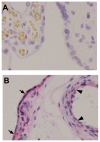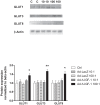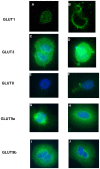Adenoviral-mediated placental gene transfer of IGF-1 corrects placental insufficiency via enhanced placental glucose transport mechanisms
- PMID: 24019972
- PMCID: PMC3760855
- DOI: 10.1371/journal.pone.0074632
Adenoviral-mediated placental gene transfer of IGF-1 corrects placental insufficiency via enhanced placental glucose transport mechanisms
Abstract
Previous work in our laboratory demonstrated that over-expression of human insulin-like growth factor -1 (hIGF-1) in the placenta corrects fetal weight deficits in mouse, rat, and rabbit models of intrauterine growth restriction without changes in placental weight. The underlying mechanisms of this effect have not been elucidated. To investigate the effect of intra-placental IGF-1 over-expression on placental function we examined glucose transporter expression and localization in both a mouse model of IUGR and a model of human trophoblast, the BeWo Choriocarcinoma cell line.
Methods: At gestational day 18, animals were divided into four groups; sham-operated controls, uterine artery branch ligation (UABL), UABL+Ad-hIGF-1 (10(8) PFU), UABL+Ad-LacZ (10(8) PFU). At gestational day 20, pups and placentas were harvested by C-section. For human studies, BeWo choriocarcinoma cells were grown in F12 complete medium +10%FBS. Cells were incubated in serum-free control media ± Ad-IGF-1 or Ad-LacZ for 48 hours. MOIs of 10∶1 and 100∶1 were utilized. The RNA, protein expression and localization of glucose transporters GLUT1, 3, 8, and 9 were analyzed by RT-PCR, Western blot and immunohistochemistry.
Results: In both the mouse placenta and BeWo, GLUT1 regulation was linked to altered protein localization. GLUT3, localized to the mouse fetal endothelial cells, was reduced in placental insufficiency but maintained with Ad-I GF-1 treatment. Interestingly, GLUT8 expression was reduced in the UABL placenta but up-regulated following Ad-IGF-1 in both mouse and human systems. GLUT9 expression in the mouse was increased by Ad-IGF-1 but this was not reflected in the BeWo, where Ad-IGF-1 caused moderate membrane relocalization.
Conclusion: Enhanced GLUT isoform transporter expression and relocalization to the membrane may be an important mechanism in Ad-hIGF-1mediated correction of placental insufficiency.
Conflict of interest statement
Figures






Similar articles
-
Regulation of amino acid transporters by adenoviral-mediated human insulin-like growth factor-1 in a mouse model of placental insufficiency in vivo and the human trophoblast line BeWo in vitro.Placenta. 2014 Feb;35(2):132-8. doi: 10.1016/j.placenta.2013.11.012. Epub 2013 Dec 6. Placenta. 2014. PMID: 24360522 Free PMC article.
-
Intraplacental gene therapy with Ad-IGF-1 corrects naturally occurring rabbit model of intrauterine growth restriction.Hum Gene Ther. 2015 Mar;26(3):172-82. doi: 10.1089/hum.2014.065. Hum Gene Ther. 2015. PMID: 25738403 Free PMC article.
-
Development of Non-Viral, Trophoblast-Specific Gene Delivery for Placental Therapy.PLoS One. 2015 Oct 16;10(10):e0140879. doi: 10.1371/journal.pone.0140879. eCollection 2015. PLoS One. 2015. PMID: 26473479 Free PMC article.
-
Glucose transporters in the human placenta.Placenta. 2000 Jan;21(1):14-22. doi: 10.1053/plac.1999.0448. Placenta. 2000. PMID: 10692246 Review.
-
Spatial and temporal patterns of expression of messenger RNA for insulin-like growth factors and their binding proteins in the placenta of man and laboratory animals.Placenta. 2000 May;21(4):289-305. doi: 10.1053/plac.1999.0498. Placenta. 2000. PMID: 10833363 Review.
Cited by
-
Nanoparticle-mediated transgene expression of insulin-like growth factor 1 in the growth restricted guinea pig placenta increases placenta nutrient transporter expression and fetal glucose concentrations.Mol Reprod Dev. 2022 Nov;89(11):540-553. doi: 10.1002/mrd.23644. Epub 2022 Sep 12. Mol Reprod Dev. 2022. PMID: 36094907 Free PMC article.
-
Placental expression of glucose transporters GLUT-1, GLUT-3, GLUT-8 and GLUT-12 in pregnancies complicated by gestational and type 1 diabetes mellitus.J Diabetes Investig. 2022 Mar;13(3):560-570. doi: 10.1111/jdi.13680. Epub 2021 Oct 21. J Diabetes Investig. 2022. PMID: 34555239 Free PMC article.
-
Corticosterone alters materno-fetal glucose partitioning and insulin signalling in pregnant mice.J Physiol. 2015 Mar 1;593(5):1307-21. doi: 10.1113/jphysiol.2014.287177. Epub 2015 Jan 29. J Physiol. 2015. PMID: 25625347 Free PMC article.
-
Interventions for placental insufficiency and fetal growth restriction.Placenta. 2022 Jul;125:4-9. doi: 10.1016/j.placenta.2022.03.127. Epub 2022 Apr 4. Placenta. 2022. PMID: 35414477 Free PMC article.
-
Differential Expression of Glucose Transporter Proteins GLUT-1, GLUT-3, GLUT-8 and GLUT-12 in the Placenta of Macrosomic, Small-for-Gestational-Age and Growth-Restricted Foetuses.J Clin Med. 2021 Dec 13;10(24):5833. doi: 10.3390/jcm10245833. J Clin Med. 2021. PMID: 34945129 Free PMC article.
References
-
- Joost HG, Bell GI, Best JD, Birnbaum MJ, Charron MJ, et al. (2002) Nomenclature of the GLUT/SLC2A family of sugar/polyol transport facilitators. Am J Physiol Endocrinol Metab. 282: E974–976. - PubMed
-
- Illsley NP (2000) Glucose transporters in the human placenta. Placenta 21: 14–22. - PubMed
-
- Limesand SW, Regnault TR, Hay WW Jr (2004) Characterization of glucose transporter 8 (GLUT8) in the ovine placenta of normal and growth restricted fetuses. Placenta 25: 70–77. - PubMed
Publication types
MeSH terms
Substances
Grants and funding
LinkOut - more resources
Full Text Sources
Other Literature Sources
Miscellaneous

